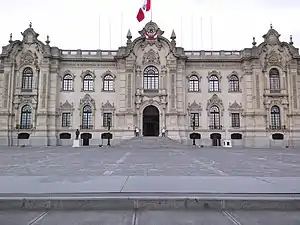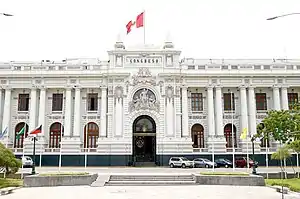| 2019–2020 Peruvian constitutional crisis | |||
|---|---|---|---|
| Part of the 2017–present Peruvian political crisis | |||
  Top to bottom: Government Palace, seat of Peru's presidency. Legislative Palace, meeting place of the Congress of Peru | |||
| Date | 30 September 2019 – 14 January 2020 (3 months and 15 days) | ||
| Location | |||
| Goals |
| ||
| Methods |
| ||
| Resulted in |
| ||
| Parties | |||
| |||
| Lead figures | |||
| Peruvian political crisis |
|---|
 |
| Causes |
| Events |
|
| Elections |
| Protests |
| Armed violence |
|
|
The 2019–2020 Peruvian constitutional crisis began when President Martín Vizcarra dissolved the Congress of Peru on 30 September 2019 considering a de facto denial of the vote of confidence.[1] The majority of lawmakers,[2][3] opponents[4][5] and Fujimorists[6] viewed Vizcarra's actions as a "coup" or "self-coup"[7] while some compared the event to the 1992 Peruvian self-coup.[8][9] Congress responded by declaring Vizcarra's presidency suspended and appointed Vice President Mercedes Aráoz as interim president.[1][10] During the evening hours, the heads of the Peruvian Armed Forces shared a photograph beside Vizcarra in the Government Palace amidst the crisis, putting forward their support for him.[11][12]
By the next day, 1 October 2019, Congress' moves were largely seen as null and void;[1][10] interim president Aráoz announced her resignation and Vizcarra issued a decree for legislative snap elections to be held on 26 January 2020.[10]
Background
The presidency of Peru and the Congress of Peru have been in conflict since the beginning of the tenure of former President Pedro Pablo Kuczynski in 2016. On 15 September 2017, Congress passed, by a wide margin, a motion of no confidence against the prime minister and the cabinet, leading to a complete overhaul of the cabinet and appointment of a new prime minister.[13][14]
Kuczynski resigned from office in March 2018, when the vote-buying Kenjivideos scandal broke. He was replaced by First Vice President, Martín Vizcarra.[15]
Vizcarra made anti-corruption initiatives his main priority,[1] pushing for a constitutional referendum to prohibit private funding for political campaigns, to ban the re-election of lawmakers, and to create a second legislative chamber.[16] Transparency International praised the move: "This is a very important opportunity, one that is unlike previous opportunities because, in part, the president appears genuinely committed."[17]
While Vizcarra pursued actions against corruption, political leader Keiko Fujimori was arrested in October 2018 on money laundering and corruption charges related to the Odebrecht scandal.[18][19] The Fujimorists of the Popular Force party held the majority of seats in the Congress of Peru and had made Vizcarra's efforts complicated since he was vice president.[20] Following the arrest of Fujimori, the Fujimorist-led congress introduced a bill to change Vizcarra's referendum proposals.[19] Peruvians ultimately agreed with Vizcarra's proposals during the referendum in December 2018.[21]
No-confidence law
In the Constitution of Peru, the executive branch can dissolve Congress after a second vote of no-confidence.[14][1] The first vote of no-confidence occurred in September 2017.[13]
Demanding reforms in the Constitutional Court organic law, Vizcarra called for a vote of no confidence on 27 September 2019, stating it was "clear the democracy of our nation is at risk".[14] Vizcarra and the Inter-American Commission on Human Rights criticized Congress for blocking a proposal for general elections while it quickly approved nominations to the Constitutional Court of Peru without investigating the backgrounds on nominees.[14] Vizcarra sought to reform the Constitutional Court nomination process and Congress' approval or disapproval of his proposal was seen "as a sign of confidence in his administration".[14]
Events
Constitutional Court nominations
The Congress scheduled the election of the new members to the Constitutional Court of Peru for September 30.
On September 30, the prime minister Salvador del Solar went to the Legislative Palace to request the approval of an amendment to the Organic Law of the Constitutional Court as a matter of confidence. However, the Congress scheduled the minister to the afternoon. While the congress started the debate for the election of the new judges, the prime minister entered the Congress hemicycle room. Del Solar addressed the lawmakers to vote to reform the Constitutional Court nomination process. However, the Congress decided to postpone the vote of the amendment to the afternoon.
The Congress named a new member to the Constitutional Court of Peru.[1] Many of the Constitutional Court nominees selected by Congress were alleged to be involved in corruption.[22] Hours later, the Congress approved the confidence motion.
Dissolution of Congress
Notwithstanding the affirmative vote, Vizcarra stated that the appointment of a new member of the Constitutional Court constituted a de facto vote of no confidence.[1][23] He said that it was the second act of no-confidence in his government, granting him the authority to dissolve Congress.[24] These actions by Congress, as well as the months of slow progress towards anti-corruption reforms, pushed Vizcarra to dissolve the legislative body on 30 September, with Vizcarra stating "Peruvian people, we have done all we could."[1]
Congress declares interim president
Shortly after Vizcarra announced the dissolution of Congress, the legislative body refused to recognize the president's actions, declared Vizcarra as suspended from the presidency, and named Vice President Mercedes Aráoz as the interim president of Peru.[1] Despite this, Peruvian government officials stated that the actions by Congress were void as the body was officially closed at the time of their declarations.[1] By the night of 30 September, Peruvians gathered outside of the Legislative Palace of Peru to protest against Congress and demand the removal of legislators[1] while the heads of the Peruvian Armed Forces shared a photograph of themselves with Vizcarra in the Government Palace, announcing that they recognized him as president of Peru and head of the armed forces.[11][12]
Resignation of Aráoz
During the evening of 1 October 2019, Mercedes Aráoz, whom Congress had declared interim president, resigned from office.[10] Aráoz resigned, hoping that the move would promote the new general elections proposed by Vizcarra and postponed by Congress.[10][1] President of Congress Pedro Olaechea was left momentarily speechless when informed of Aráoz's resignation during an interview.[25] At the time, no governmental institution or foreign government recognized Aráoz as president.[25]
Constitutional Court rules in favor of Vizcarra
On 10 October 2019, Olaechea, who was now President of the Permanent Assembly, submitted a claim with the Constitutional Court against the Vizcarra government over its dissolution of Congress.[26] The court, on 9 January 2020, ruled in its Judgment of the Constitutional Court of Peru over the dissolution of Congress on 30 September 2019 that the claim filed by Olaechea was unfounded, that dissolution of Congress was legal and declared that Congress preventing the executive branch from raising questions of confidence was unconstitutional.[26][27]
Legislative elections decreed
Vizcarra issued a decree calling for legislative elections on 26 January 2020.[10] The Organization of American States released a statement saying that the Constitutional Court could determine the legality of President Vizcarra's actions and supported his call for legislative elections, saying "It's a constructive step that elections have been called in accordance with constitutional timeframes and that the definitive decision falls to the Peruvian people".[25]
Reactions
Media
The Wall Street Journal would write, "Mr. Vizcarra's move against Congress echoed a parliamentary coup carried out in 1992 by then-President Alberto Fujimori".[9] Christine Armario of the Associated Press wrote, "The dissolution of congress has plunged Peru into its deepest constitutional crisis in nearly three decades, and it may also be the start of a final, bleak chapter for the country's most prominent political dynasty. When the legislature was last shut down in 1992, strongman Alberto Fujimori sat in the presidential palace calling the shots. Fast forward 27 years, and now it is the party led by his cherished eldest daughter that is being kicked out".[8]
Politicians
Lawmakers, Fujimorists and other opponents viewed President Vizcarra's actions as a "coup" or "self-coup",[2][4][6][7] with the right-wing members of Congress saying that Vizcarra was working with leftist politicians, arguing that Peru would become "another Venezuela".[28] Former Mayor of Lima and attorney Jorge Del Castillo responded to the dissolution, stating "We call on the armed forces of Peru, we call on the national police of Peru, not to lend their support to this coup d’état. He and his ministers will end up in prison".[4] Juan Sheput, cofounder of Contigo, stated "Vizcarra, like any dictator, proposes to dissolve Congress".[3]
Public opinion
Public opinion polls by the Institute of Peruvian Studies (IEP) showed that 84% of respondents approved of Vizcarra's move to dissolve Congress.[23] A similar poll by Peruvian pollster CPI found 89.5% of respondents supported the dissolution of Congress.[29]
Martín Vizcarra
The contested President Martín Vizcarra questioned the legality of the Congressional inauguration of Vice President Mercedes Aráoz as Interim President and the members involved in this act of challenge of authority.
You can't just say 'I've sworn in as President, but I was just kidding.' Swearing into a public office in a legislative institution in front of a congressional audience is a legal action in the moment.
See also
References
- 1 2 3 4 5 6 7 8 9 10 11 12 "Peru's president dissolves Congress to push through anti-corruption reforms". The Guardian. 1 October 2019. ISSN 0261-3077. Retrieved 1 October 2019.
- 1 2 "Peru president dissolves congress amid anti-corruption push". Associated Press. 1 October 2019. Retrieved 24 April 2023.
- 1 2 Dwyer, Colin (1 October 2019). "Peru's President Dismisses Lawmakers; Lawmakers Dismiss Peru's President". NPR.
- 1 2 3 "Peru president dissolves congress and calls for elections". Financial Times. 1 October 2019. Retrieved 24 April 2023.
- ↑ "Peru military, police back Vizcarra as rebel lawmakers vow loyalty to VP". Reuters. 30 September 2019. Retrieved 24 April 2023.
- 1 2 "Explained: Peru's chaotic power struggle in a nutshell". The Indian Express. 2 October 2019. Retrieved 24 April 2023.
- 1 2 "4 claves para entender la crisis política que atraviesa Perú tras la disolución del Congreso (y lo que puede pasar ahora)". BBC News (in Spanish). Retrieved 24 April 2023.
- 1 2 "Dark days for Peru's political dynasty after congress closes". Associated Press. 4 October 2019. Retrieved 7 October 2019.
- 1 2 Otis, Juan Montes and John. "Peruvian Vice President Resigns After Congress Fails to Oust Nation's Leader". The Wall Street Journal. Retrieved 24 April 2023.
- 1 2 3 4 5 6 "Peru's vice-president resigns amid power struggle". BBC News. 2 October 2019. Retrieved 2 October 2019.
- 1 2 "Peru's Police and the Joint Command of Peru's Military Branches Say They Recognize Vizcarra as President and the Head of the Armed Forces and Police-Statements". Reuters. 1 October 2019. Retrieved 1 October 2019.
- 1 2 "Cierre del Congreso | Perú | Martín Vizcarra: Fuerzas Armadas acuden a Palacio de Gobierno para reunión". Peru.21 (in Spanish). 1 October 2019. Retrieved 25 April 2023.
- 1 2 "Peru's leader names new prime minister as he reforms Cabinet". Associated Press. 18 September 2017. Retrieved 1 October 2019.
- 1 2 3 4 5 Briceno, Franklin (27 September 2019). "Peru leader pushes vote that could let him dissolve congress". The Washington Post. Archived from the original on 1 October 2019. Retrieved 1 October 2019.
- ↑ Quigley, John (21 March 2018). "Vizcarra Set to Become Peru's New President Facing Daunting Challenges". Bloomberg. Retrieved 22 March 2018.
- ↑ Taj, Mitra. "Peru president proposes referendum on political, judicial reform". Reuters. Retrieved 17 August 2018.
- ↑ Tegel, Simeon (12 August 2018). "Corruption scandals have ensnared 3 Peruvian presidents. Now the whole political system could change". The Washington Post. Retrieved 17 August 2018.
- ↑ Collyns, Dan (10 October 2018). "Peru opposition leader Keiko Fujimori detained over 'money laundering'". The Guardian. Retrieved 10 October 2018.
- 1 2 "Referéndum | Congresistas presentan proyecto para retirar la bicameralidad y no reelección de congresistas" [Referendum | Congressmen present project to withdraw bicamerality and non-reelection of congressmen]. RPP (in Spanish). 12 October 2018. Retrieved 10 December 2018.
- ↑ Chávez, Paulo Rosas (23 May 2017). "Martín Vizcarra: entre la reconstrucción y su renuncia por Chinchero" [Martín Vizcarra: between the reconstruction and his resignation for Chinchero]. El Comercio (in Spanish). Retrieved 23 March 2018.
- ↑ Briceno, Franklin (9 December 2018). "Exit polling indicates Peruvians vote to fight corruption". The Miami Herald. Retrieved 10 December 2018.
- ↑ Zarate, Andrea; Casey, Nicholas (3 October 2019). "How a Political Crisis Seized Peru: Boom Times, Corruption and Chaos at the Top". The New York Times. ISSN 0362-4331. Retrieved 8 October 2019.
- 1 2 "Disolución del Congreso | Martín Vizcarra | 84% de peruanos apoya la disolución del Congreso" [Dissolution of Congress | Martín Vizcarra | 84% of Peruvians support the dissolution of Congress]. RPP (in Spanish). 6 October 2019. Retrieved 7 October 2019.
- ↑ "Peru has been thrown into a constitutional crisis. Allies must support a solution that preserves its social progress". The Washington Post. 2 October 2019. Retrieved 7 October 2019.
- 1 2 3 "Peru's VP gives up claim to the presidency in blow to opposition". Reuters. 2 October 2019. Retrieved 7 October 2019.
- 1 2 "Expediente 0006-2019-CC/TC SENTENCIA DEL TRIBUNAL CONSTITUCIONAL Case sobre la disolución del Congreso de la República" (PDF). Constitutional Court of Peru. 14 January 2020.
- ↑ "Versión de Alejandro Muñante acerca de que el TC anuló posibilidad de cuestión de confianza por reformas constitucionales no es cierta". Ojo Público (in Spanish). 13 October 2021. Retrieved 15 August 2023.
- ↑ "Peru plunges into political crisis, bringing dark days for a dynasty". PBS NewsHour. 4 October 2019. Retrieved 24 April 2023.
- ↑ "Disolución del Congreso: 89.5% está de acuerdo, según encuesta" [Dissolution of Congress: 89.5% agree, according to survey]. Metro International (in Spanish). 5 October 2019. Archived from the original on 8 October 2019. Retrieved 8 October 2019.